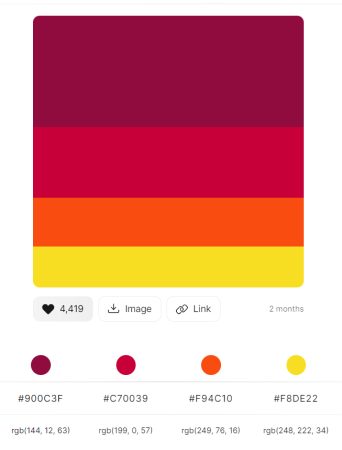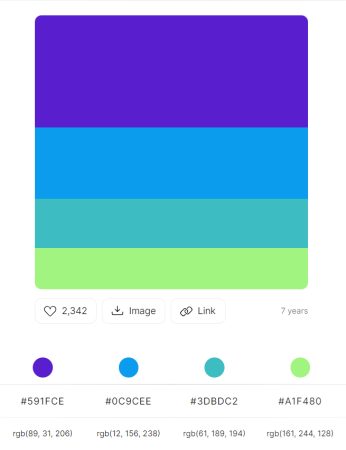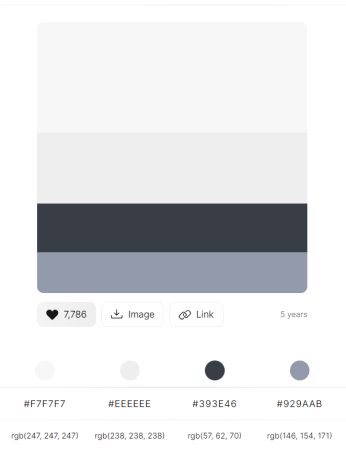Color choices are not just aesthetics; they’re the architects of user experience and perceptions. The choices made in selecting website colors play a pivotal role in molding the user experience and shaping how individuals perceive your business. In this article, we will take a rainbow-worthy peek into the intriguing realm of color psychology for web design, simplifying it into easily digestible pieces. We’ll uncover the emotional impact of various colors, their symbolic significance, and how they can be effectively harnessed to craft a visually pleasing and functional website that profoundly connects with visitors.
The Basics of Color Psychology for Web Design
Let’s start by understanding the fundamental connection between color and emotion. Colors have the remarkable ability to evoke feelings, associations, and even memories. Just as music evokes emotions and feelings when it enters our ears, colors do the same through our eyes-brain connection.
For example, when you see a vibrant red, you might feel a rush of excitement or passion. In contrast, a serene blue can instill a sense of calm and trust. These emotional responses to color are universal, transcending language and culture.
However, it’s important to acknowledge that the interpretation of colors is not entirely universal. Cultural factors play a significant role in shaping our perceptions. For instance, while white symbolizes purity and weddings in Western cultures, it signifies mourning and funerals in some Asian cultures. Understanding these cultural nuances is essential when designing a website intended for a global audience.
Choosing the Right Color Palette for Your Website
Consistency is key when it comes to color palettes in web design. Using a consistent color scheme across your website fosters a sense of cohesiveness and professionalism. It helps users navigate your site effortlessly, as they can associate specific colors with different elements, like buttons or headings.
Creating contrast is another essential aspect of color selection. Contrast ensures that the text is legible, and important elements stand out. A high level of contrast between text and the background is particularly crucial for accessibility, as it accommodates users with visual impairments.
Warm Colors: Energetic and Inviting

Red: The Color of Passion and Urgency
Red is the color of passion, excitement, and urgency. It can grab the attention of visitors and evoke strong emotions. This is why it’s often used for “Buy Now” buttons or warnings. However, using too much red can be overwhelming, so balance is key.
Orange: Friendly and Playful
Orange is a warm and friendly color associated with playfulness and enthusiasm. It can create a welcoming atmosphere on your website. For brands looking to appear approachable and fun, orange is an excellent choice.
Yellow: Optimism and Positivity
Yellow radiates optimism and positivity. It’s a color that exudes happiness and energy. When used in web design, it can convey a sense of warmth and friendliness, making users feel comfortable and uplifted.
Cool Colors: Calm and Trustworthy
Blue: Serenity and Trust
Blue is often linked to serenity, trust, and reliability. It’s a popular choice for businesses and financial websites, as it instills a sense of security. Blue is versatile and works well with various other colors.
Green: Freshness and Growth
Green symbolizes freshness, growth, and nature. It’s a calming color that represents health and vitality. Many environmentally conscious brands use green to convey their commitment to sustainability.

Pink: Playful or Sophisticated
The color pink is often associated with qualities like compassion, playfulness, and warmth. Lighter shades of pink, such as pastel hues, can convey a sense of innocence and sweetness, making them ideal for brands focused on youthfulness or creativity. On the other hand, deeper shades of pink, like magenta, may exude sophistication and modernity.
Purple: Royalty and Creativity
Purple is a regal color associated with creativity and luxury. It can add a touch of sophistication to your website. However, it’s essential to use purple carefully, as too much can be overwhelming.
Neutrals: Balance and Simplicity

White: Purity and Cleanliness
White is the color of purity, cleanliness, and simplicity. It provides a sense of openness and is often used in minimalist designs. White backgrounds can make content easy to read and navigate.
Gray: Timelessness and Professionalism
Gray is a timeless and professional color that adds sophistication to a website. It’s often used for text and background colors to create a balanced and elegant look. Many tech companies incorporate gray into their branding.
Black: Elegance and Mystery
Black exudes elegance and mystery. It’s a bold choice that can add a touch of luxury to your web design. When used in moderation, black can create a striking contrast and emphasize important elements.
Creating a Visual Hierarchy along with Color Psychology
Color plays a crucial role in creating a visual hierarchy on your website. You can use color to draw attention to specific elements, such as call-to-action buttons or important messages. This helps users navigate your site with ease.
Inclusive web design is about ensuring that everyone can access and use your website, regardless of their abilities. When choosing colors, consider the contrast between text and background to make sure your content is readable for all users.
Color Combinations: Harmonious or Chaotic?
Complementary Colors: Vibrancy and Balance
Complementary colors are opposite each other on the color wheel, such as red and green. When used together, they create a vibrant and balanced contrast that can make your website visually appealing.
Analogous Colors: Subtlety and Cohesion
Analogous colors are adjacent to each other on the color wheel, like blue and green. They create a more subtle and harmonious combination, ideal for creating a cohesive and peaceful atmosphere on your website.
Triadic Colors: Dynamic and Diverse
Triadic colors are evenly spaced on the color wheel, such as red, yellow, and blue. This combination offers a dynamic and diverse palette that can add excitement and variety to your web design.
The Connection Between Brand Identity and Color Psychology
The colors that define your brand are an integral aspect of your distinct brand identity. They evoke emotions and leave a lasting impression on your audience. Consider the psychological associations of your brand colors and how they align with your values and message.
Let’s take a look at some famous brands and their use of color. For example, McDonald’s golden arches use red and yellow to evoke hunger and excitement, while the serene blue found in various financial institutions conveys a sense of trust and dependability.
The Rise of Dark Mode in Web Design
Dark mode, with its dark background and light text, has gained popularity in recent years. It offers a sleek and modern aesthetic, reducing eye strain in low-light conditions. Many websites and apps now provide a dark mode option.
Pros and Cons of Dark Mode
While dark mode has its advantages, such as reducing battery consumption on OLED screens and being easier on the eyes in low-light environments, it’s not suitable for all situations. Some users still prefer the traditional light mode, so offering both options can enhance user experience.
Color Psychology for Web Design Conclusion
Weaving Emotions with Pixels: Every color choice is an opportunity to influence your visitors. Whether you’re aiming for a website that exudes passion, trust, or creativity, understanding the color psychology for web design is your key to success. By embracing the power of color, you can create a virtual space that resonates with your audience, leaving a lasting impact.
CONNECT:SHARE:
